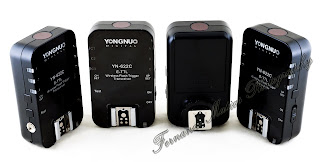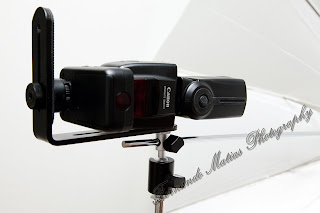While I was researching radio flash triggers I knew that my choices were going to be limited since I insisted on keeping Canon’s E-TTL capabilities. Yes, manual flash settings are usually the way to go to make sure you get the exact amount of light you want, but during weddings and events where the subject is constantly on the move E-TTL is a must, and just as good if you know how to use it to your advantage. There are very few radio triggers on the market that can do TTL, and the technology to do so is still somewhat in its infancy. The pocketwizard solution was fairly expensive, and it has interference problems with one of my flashes (580EXII). The pixel kings were in the right price range, but at the time they did not have all of the E-TTL features available that I regularly use (ratios!). So once I found out about the Yongnuo YN-622c I was intrigued and hoped that it would really provide everything it claimed. My first mission was to find a reputable realtor to buy a set since these triggers are not widely available in your local camera store and only obtainable online from Hong Kong. I decided on purchasing my first set direct from Yongnuo’s ebay store and was pleasantly surprised that they arrived at my door in exactly 1 week from order date! I was so impressed with the shipping time, communication with the seller, and first impressions of the product that I ordered another set that night! This second set took over 3 weeks to arrive at my door so shipping times may vary, but in the end I think ordering direct from Yongnuo was still a fairly positive experience.
My first impressions of the product itself were quite positive all around. They arrived in a simple package that contained the bare minimum, a box containing two transceivers in bubble wrap bags, a quick guide, and a manual. It would have been nice if they also came with storage bags and/or PC sync chords, but they can easily be purchased separately if needed anyway. They are sturdy and feel rugged enough for everyday use and do not feel like they are going to fall apart anytime soon. The hotshoe base is made of metal which makes them feel very solid when engaged on top of the camera. The locking mechanism is the basic screw holder variety which works well; however, it would have been nice to have some sort of weather sealing. Of course that’s just a pipe dream for something in this price range! Each transceiver is both a receiver and transmitter so if one does die you essentially have a backup for each type as long as you have more than 2 of these. They use regular AA batteries which are always easy to find anywhere when needed, and there is an on/off switch so you can be sure your batteries are not going to be dead from unintended use when you pull these out of your camera bag.
There are no LCD screens on the units themselves and only three buttons on the sides, but this is because all of the settings are actually done in your own on camera menu system if you are using a Class A camera body (which is basically anything new since the days of the XSi). I thought this was absolutely an ingenious way of adjusting the settings; since it’s already found in the camera itself why bother reinventing the wheel! The information is then transmitted to the receivers by the transmitter on the camera, so there is no need to access your flashes once you have them set up! The three buttons (Test, CH Set, GP Set) will allow you to quickly change the channel, group, or fire a test flash, but basically everything else is done in the camera’s own menu system. The only problem I have with the buttons is that it is somewhat easy to accidentally press them when turning the system on. There is also a PC Sync port on the device which could benefit those who use studio strobes. The front of the transmitter has a focus assist laser, which in all honesty is not very good. It works fairly well if your subject is far enough from the camera and does accurately aid in focusing, but once the subject is within a few feet the alignment is off making the light pattern way too high and does not cover most of the focus points, not even the center point! This makes it useless in close range.
After using these for a few weeks now I can safely say that the Yongnuo YN-622c really does deliver on its claim to fully implement Canon’s E-TTL system and all of the modern flash features using wireless radio signals. Using the menu system you can switch between E-TTL (both Evaluative and Average), Manual, and Multi-Flash Stroboscopic modes. Yes, it's the best of both worlds with E-TTL or Manual settings if you choose! You can even setup the transceivers to work in a mixed mode where you can mix multiple E-TTL and manual flashes at the same time! 1st curtain, 2nd curtain (only if wireless is disabled) and Hi-speed sync (HSS) modes are all available. Flash Exposure Bracketing (FEB) is possible in a range from -6 to +6EV, while Flash Exposure Compensation (FEC) can be used from -3 to +3EV but will also add any on-flash settings for the possibility of more. Most importantly for me is that group ratios are available for use in both E-TTL and manual wireless modes. Either way all three firing groups are available (A+B+C, A:B and A:B C) and easily controlled in the camera menu system with no need to access the flash units themselves other than the initial group selection on the transceiver during setup. The best part of this system, and the main reason I bought them, is that it does all this using 2.4Ghz radio signals instead of Canon’s Infrared wireless system. The major benefit of this is that I no longer require line of sight and can place my flashes anywhere, even behind walls if I want to! The signal range has not disappointed and has worked flawlessly even behind walls or in awkward out of sight locations. This has not only increased the possibilities of getting more creative with my flash placement, but has also removed any worry about me stepping out of line of sight of the secondary flashes and having them not go off for a string of shots during a more hectic shoot such as a wedding.
A minor problem I knew would happen once I put these into my current setup is that the added height of the transmitter under my flash would throw off the alignment of my flash and my flash umbrella. The added height would raise the flashes area of coverage from the center of the umbrella reducing its effectiveness as a diffuser. However, this was easily corrected by the purchase of an L-bracket which actually aligned my flash even better than I had it before.
The only issue I was unaware of and only identified after purchase was that the YN-622c’s will incorrectly completely overexpose the photo if you use a pre-flash when you combine a Canon 5D mkII with a Canon 580EXII off camera and have wireless mode disabled. For some reason this only happens in this exact combination, as I have tested several other camera bodies (Canon 1DX, T3i, XTi) and flashes (Canon 600EX-RT, 420EX) with no problems. To make sure this was always the case I used two different Canon 5D mkII’s and Canon 580EXII’s, and with any combination of these it always miss fired. I also tried different sets of YN-622c’s with no change. Although this could be an issue for some, I found that for my work it would not since in most cases I would have wireless enabled anyway which resolves the problem. This problem is also resolved as soon as another acceptable flash is introduced into the mix such as having a Canon 420EX also off camera. Since most of the time I use more than one flash, and have wireless enabled, this problem for me is technically a non-issue.
So if you are looking to set up your game and go to off camera lighting with E-TTL without the worry of having line of sight then the Yongnuo YN-622c transceivers is a great system if you already have some flashes in your kit and do not want to spend big money on the new Canon 600EX-RT’s.





Where did you purchase the L bracket for speedlite?
ReplyDeleteThe place I bought it from no longer seems to carry this item any more. You can find photography related L brackets almost anywhere photography accessories are sold. Try Ebay or even here: http://www.dx.com/s/l+bracket
Delete